
|   |

|   |
Chitra Katha: A picture and a narrative - Satish Suri e-mail: satishism@yahoo.co.in Photos: Chadha & Co December 8, 2018 The thematic presentation Chitra Katha of IDA-2018, under the auspices of Padmalaya Dance Foundation, sought to explore the story within a still life painting giving a dynamic dimension to the canvass the artists painted. 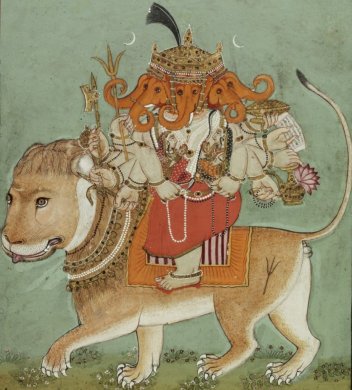 Heramba Ganapathi 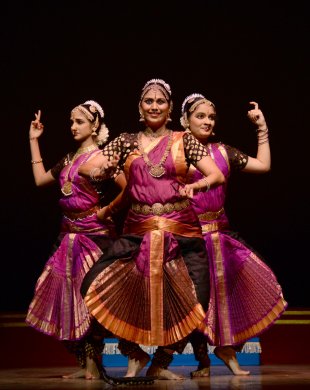 Padmalaya Dance Ensemble The first presentation was by the Padmalaya Dance Ensemble, "Heramba Ganapathi" inspired by the iconographical painting of the five-headed Ganapathi symbolising the protector, who blesses that he will remove all suffering and bring eternal happiness.The artists Poornima Kaushik, Ranjita Kumar, Poshini Zunzurwad using mime, postures, formations and movements, highlighted the many features of the five-headed Heramba who rides the lion -the Devi's vehicle. Ten armed, he holds the noose, the tusk, the aksharamala, the axe, the modaka and the mallet.The five heads represent the five koshas or gross subtle nature of our bodies. The son of Maheswara also points to the five cardinal directions that symbolise the five elements of Earth, Water, Fire, Wind and Space. He is the ultimate protector of all. The narrative sequences attractively choreographed had clarity and visual richness in the angikas embellished by the live orchestra support with Vasudha Balakrishna (vocals), Guru Padma Murali (nattuvangam), V.R.Chandrasekhar (mridangam) and Jayaram (flute). 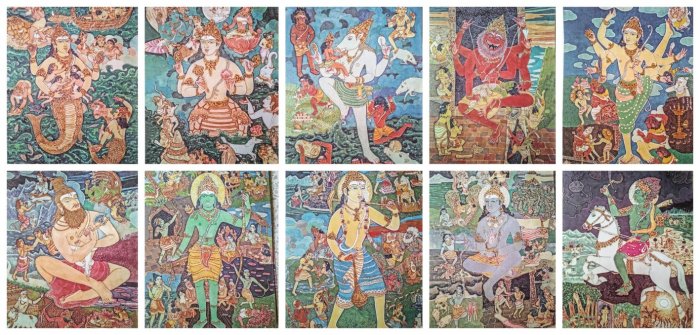 Dasavataram 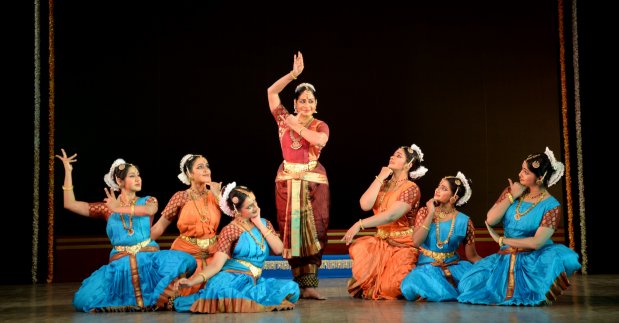 Lakshmi Ramaswamy & group Dr. Lakshmi Ramaswamy's Sri Mudhraalaya and her team of dancers showcased 'Dasavataram' drawing inspiration from the paintings of S.Rajam and the lyrics of Dr. S.Raghuraman, set to music by Rajkumar Bharati. Lakshmi Ramaswamy, along with her students Purnima Sriraman, Jagyaseni Chatterjee, Divya Srilakshmi, Lalitha Narasimhan, Monica and Tanya Shravan presented well rehearsed and interesting facets that showcased Rama as a protector of Dharma.The music accentuated the nuances in the narration and several features like the episode of Parasurama killing Renuka; the Soorpanaka episode with Rama and Lakshmana, had a refreshing take with skilful visual artistry dominating the choreography and the dancers performing seamlessly to highlight the sequences in the narrative. The turning point was a perfect ending with the Seshashayana formation by the dancers providing a visual impact. 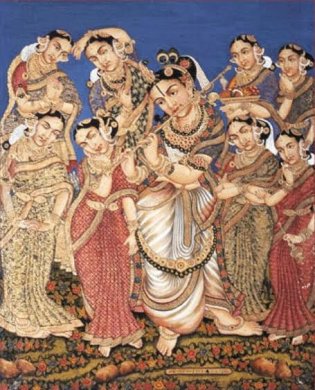 Ashta Bharyas 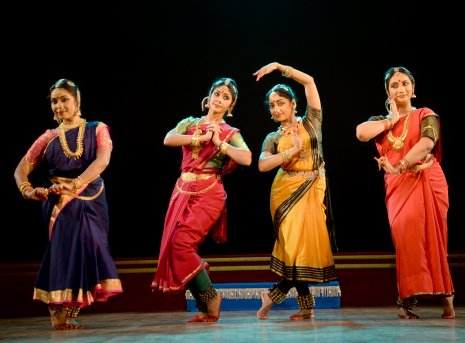 Samskruthi ensemble The Samskruthi dance ensemble trained by Satyanarayana Raju made their opening statement with "Siddhi Buddhi Sametha Ganesha" inspired by the painting seen in the magnum opus iconographic work of the Mysore Kingdom -Sri Tattavanidhi. The dancers Aditi Sadashiva, Gowri Sagar, Chaitra Jagadeesh and Pruthvi Parthasarathy with a finely articulated rendition described the attributes of Buddhi and Siddhi, the consorts of Ganesha, one representing intelligence and the other power of execution that is needed to govern the universe. This was followed by a peppy and zesty presentation of 'Ashtamahishiyaru' (Ashta Bharyas), the group of eight principal queen consorts of Lord Krishna, detailing nuggets of information about these women and their special significance to Krishna. Weaving a fascinating picture of Krishna's life with these eight extraordinary women Rukmini, Satyabhama, Jambavati, Kalindi, Mitravrinda, Nagnajiti, Bhadra and Lakshana, the four artists transported the rasikas into the story through their brisk and sprightly exploration of the unique personalities and character of the eight women. The visual metaphor and the sancharis, with a quick change of costumes, were elegantly woven into the movements embellished by the live orchestral support with Vasudha Balakrishna (vocals), Soundarya Srivatsa (nattuvangam), S.V. Balakrishna (mridangam) and Karthik Satavalli (flute) capturing the flavour of the narrative. 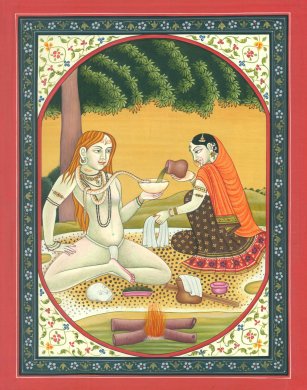

The final performance for the day was personified by innovation and artistic acumen. 'Ayam,' a presentation by Matangi Prasan and Meghna Das juxtaposed Bharatanatyam and Odissi to explain the love aspirations of two women and the two separate approaches that led them to admire two male principles, Shiva and Krishna. The first woman, Matangi imagines Shiva and his relationship with Parvati, married, equal, two parts of a whole. He is the Neelakantha and Parvati disturbed reaches out to him to prevent him from drinking the poison from the Samudra Manthan: he is the householder and asks Parvati to be his Ardhanghi; vexed by Bhasmasura, Parvati reminds him that he gives boons freely because of his compassion; the reiteration of the principle of male and female in one - Ardhanarishwara - was portrayed with a dynamic involvement in the expression and the body kinetics incorporating exuberant and beautiful lines that attributed suggestive layers to the concerned segment of the narrative. 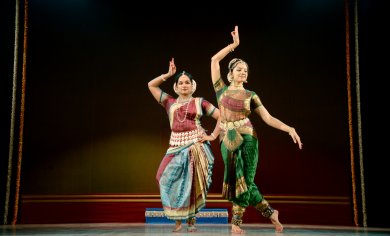
Meghna & Matangi
The second woman, Meghna explores Krishna and his relationship with Radha - intoxicated and reckless; one that embodies unconditional love. The ashtapadi provided the landscape for profound expression that revelled in the uniqueness of Lord Krishna drawing a perfect picture and bringing out the essence of divine love. The sinuous Odissi by Meghna found a dramatic contrast in the delicate gestures of Bharatanatyam by Matangi and the intricacies of the idiom was exemplified by the poignancy of the lyrics.The final freeze was an explicit imagery of the two forms, as the rhythms synergised and calibrated the movement profile to one of crisp and delicate artistry that found fulfilment for the two women in the divinity of love. Excellent music compositions on a recorded track with D.Srivatsa for Bharatanatyam and Binod Panda and Guru Dhaneswar Swain for Odissi contributed to the aesthetic exploration by the artists. The Leela Sekhar Memorial award was presented to Guru Radha Sridhar for her contribution over several decades to the dance fraternity. Bangalore based Satish Suri is an avid dance rasika besides being a life member of the Music and Arts Society. |